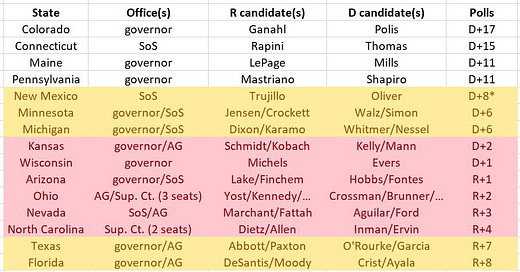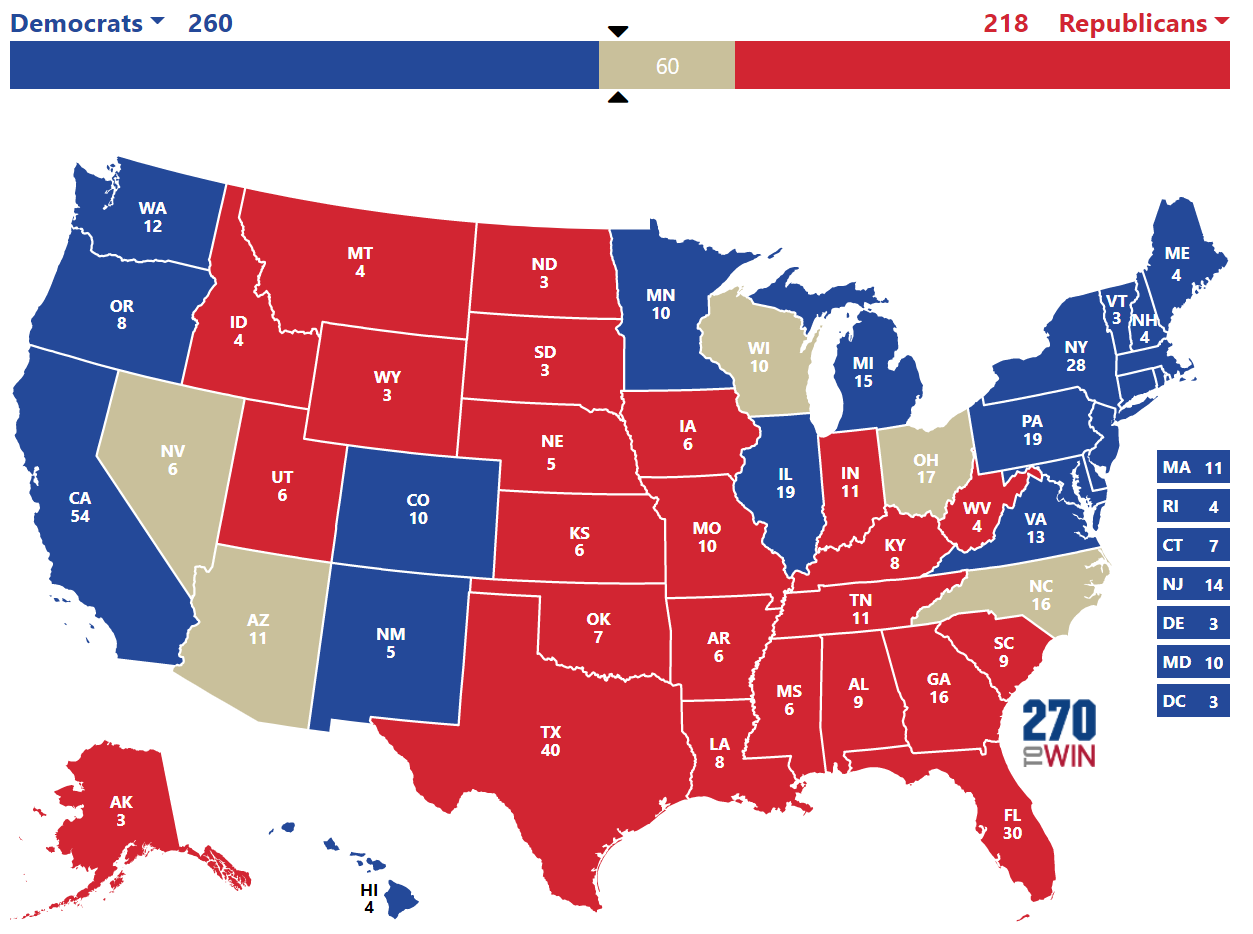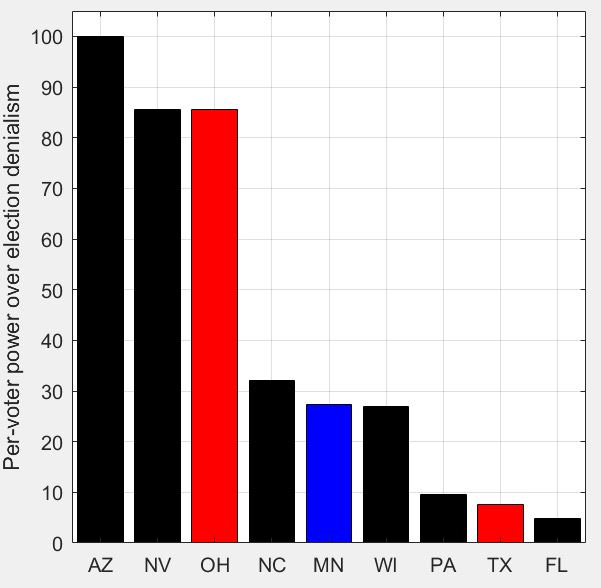Democracy Moneyball, Part 3: democracy itself
Maximize your impact on keeping elections fair in 2024.
This is the third in a three-part series on the concept of Democracy Moneyball.
Part 1: the Senate. Part 2: the House. Part 3: state-level races and the preservation of democracy in 2024.
A name like “Democracy Moneyball“ has a connotation of clean competition, at least by the modern standards of campaign finance. But what do we do if the election system itself is at risk?
In the final installment of Democracy Moneyball, I look beyond 2023, toward the 2024 election. The goal of today’s calculation is to maximize your influence over the possibility that the 2024 national election will be held according to long-accepted rules of election administration and vote counting - in other words, honestly.
The 2024 election is under threat
For most of my lifetime, the idea of nonpartisan election administration has been taken for granted. But times are changing. Since the wave of political polarization that has overtaken the United States since the mid-1990s, disputes over close elections have become increasingly acrimonious. The Bush v. Gore case in 2000 was just the tip of the iceberg. At least Bush v. Gore led to bipartisan reforms such as the Help America Vote Act. In contrast, the attempt to overturn the 2020 election has introduced partisanship to the act of vote-reporting.
On the Republican side, hundreds of candidates deny the legitimacy of the 2020 election. More than half the Republican caucus in the House of Representatives voted against certifying the electoral vote count. And in this year’s candidates for office, hundreds more “election deniers” have been documented by the Washington Post and the New York Times. All are Republicans (though it is argued that Stacey Abrams is in the same category after she raised doubts about the 2018 Georgia governor’s race after losing narrowly).
Although election denialism is not yet the official position of the Republican Party, there is no mistaking the risk to democracy that arises if the stance takes root. It’s hard to know how much of the risk is specific to Donald Trump, as opposed to general hostility to the mechanisms of democracy. For those of us who have grown up with ringing statements in favor of democracy from Ronald Reagan, George H.W. Bush, and other leaders, the new anti-democracy strain of politics is an extremely concerning development.
You can do something about this. I have turned this concern into a concrete quantitative estimate of risk. You can use this calculation to mitigate the risk in a rational manner.
Quantifying the risk of democracy catastrophe
A democracy catastrophe may occur when an official given the task of certifying the results of an election prevents the vote winner from being declared the winner. One of the largest threats is secretary of state candidate Mark Finchem of Arizona, an election denialist who attended the January 6 rally at the Capitol. Finchem has praised the insurrectionists and has sent clear signals that as secretary of state, he would be highly unlikely to certify any win by Joe Biden in 2024.
Such risks vary widely within the Republican Party. As a counterexample, in 2020 Georgia Secretary of State Brad Raffensperger, another Republican, carried out his task as expected, attracting the ire of Donald Trump.
I used the Washington Post’s searchable listing to identify election-deniers who have a role in certifying election results. (Also see Nathaniel Rakich’s important recent article.) I have furthermore identified state Supreme Court races where control of the court could go in either partisan direction (see Daniel Nichanian’s great work at Bolts magazine). The combined list looks like this:
In this table, the right-hand column lists estimated margins between the two candidates based on polls of one or more of the races listed. Asterisks indicate cases where no poll was available; in these cases, I estimated a likely margin from partisan voting index and generic Congressional preference.
Shaded in pink are six states where the margin is less than 5 points. Shaded in yellow are states where the margin is up to 10 points. Outside that range I added a few more races of interest. If you care about the conduct of the 2024 election, then the pink/yellow races are for you.
Could election deniers swing the 2024 Presidential race?
Yes, they could. Here is an electoral map indicating the states with the closest key races featuring an election denier.
Where the map is shaded red or blue, the color represents likely Presidential outcome (note that I assumed Georgia would go Republican; whichever way it goes, there is little risk of major interference).
Election-deniers may end up in key positions of responsibility in 5 states totaling 60 electoral votes. Since neither party shows 270 electoral votes in the chart, these 5 states could throw a wrench in the orderly determination of the Presidential winner.
The next step is figuring out how to optimize your efforts and donations. To calculate per-voter leverage, I will revisit a well-established calculation, per-voter power.
Per-voter power, jerseyvotes, and 2024 election risk
Since 2004, I have calculated the amount of influence that individual voters may have on the overall outcome of the Presidential election. Back then, the idea was to calculate how much one could move the probability of the national election winner by turning out one or a few voters. This voter power varies by state. For example, voters in Vermont or North Dakota have virtually no power, since they are in safe Democratic and Republican states.
Per-voter power is high in close swing states, and in states of lower population. I calculate voter power by performing a calculation of the entire election, changing one state’s vote by an infinitesimal amount, and seeing how much the national win probability changes. You can read about the calculation in this article.
Voter power in 2022…over honest elections in 2024
I did a similar calculation with state candidates. If we use this year‘s estimated margin as a measure of closeness, we can estimate the amount of leverage a 2022 voter has over the probability of a consequential legal conflict in 2024.
Putting these assumptions through the model, relative per-voter power looks like this.
I then multiplied voter power by the number of election deniers on the ballot in each state (for example, Nevada has election-denier candidates running for secretary of state and attorney general, so I multiplied the output of the calculation by two.) Finally, I scaled all states relative to Arizona, where per-voter is highest.
The fundamental drivers of these calculations are the fact that Arizona and Nevada have close races psmall populations
Of the six states with per-voter power greater than 25, we can ignore Ohio, which is a Republican state, and Minnesota, which is a Democratic state. If either of these states is close, then the Presidential election isn’t going to be close. That leaves four states: Arizona (per-voter power=100), Nevada (86), North Carolina (43), and Wisconsin (36). In these states, the orderly conduct of the 2024 election is on a knife edge and needs your help.
Optimized donations to protect the 2024 election
Democrats, to maximally protect the 2024 election, you can optimize your donations by giving at this link.
Republicans, in addition to the WinRed link, non-election-denier candidates you may support include Brad Raffensperger (secretary of state, Georgia), Mark Ronchetti (governor, New Mexico), Joe Lombardo (governor, Nevada), and Brian Kemp (governor, Georgia). Feel free to list more candidates in comments.









Donated! Thank you for the analysis. It feels good to help in a small way.
Defeating election deniers, as you are suggesting, is clearly an immediate and important goal.
But it seems the root problem is that a big chunk of the republican party simply do not want to let the country choose a leader by our constitutional rules. You mention Trump, but I suspect he is not the problem - I suspect he just uncovered it. Any thoughts on how to get the GOP to be more supportive of constitutional rules? This is a party that didn't even publish a platform of what they stood for at the last election.